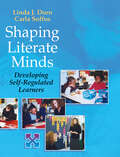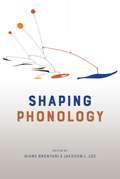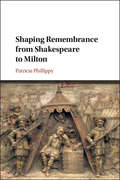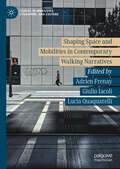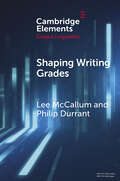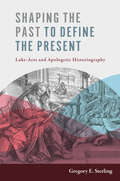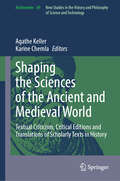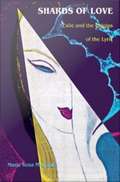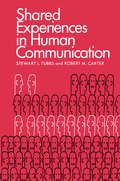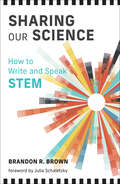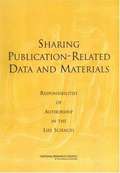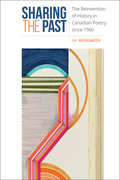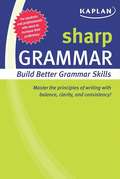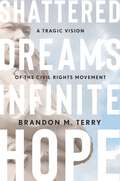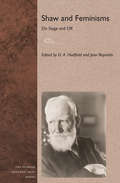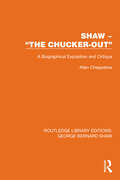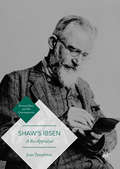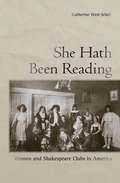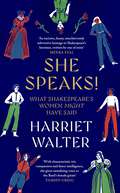- Table View
- List View
Shaping Literate Minds: Developing Self-Regulated Learners
by Linda Dorn Carla SoffosHow can teachers create a literacy curriculum that builds processing links between reading, writing, and spelling knowledge? In Shaping Literate Minds: Developing Self Regulated Learners , Linda J. Dorn and Carla Soffos illustrate how processing theory can be applied to the everyday practices of classroom teaching. If instruction emphasizes the interrelationships of these three language areas, students learn how to transfer knowledge, skills, and strategies across literacy events. This is complex theory, but the authors provide clear and practical examples to support teachers as they incorporate these ideas into their classroom practices. Grounded in authentic experiences from primary classrooms, this book provides: Explanations of processing behaviors among reading, writing, and spelling knowledgeObservational tools that support teachers in noticing changes over time in specific literacy behaviorsGuidance on creating conditions for developing self-regulated learnersAuthentic reading and writing samples and teacher/student interactionsFigures and pictures that clearly describe how teachers can use assessment to inform and guide instruction, with links to national standardsDetails for establishing a school-based literacy model that includes team meetings, assessment walls, high standards, and a curriculum for literacyAppendixes with reproducible assessment checklists, report cards, task cards for literacy corners, and guided reading observation forms for team meetingsWith a national emphasis on accountability, high standards, and literacy achievement, Shaping Literate Minds will help teachers and administrators implement a high-quality literacy curriculum that links to national and state goals.
Shaping Parliamentary Democracy: Collected Memories from the European Parliament (Palgrave Studies in European Union Politics)
by Alfredo De Feo Michael ShackletonThis book analyses nearly 100 original interviews with Members of the European Parliament from across the European Union who were active between 1979 and 2019. These interviews, preserved in the Historical Archives of the European Union at the European University Institute, capture the memories of the MEPs about their own roles and their assessment of what the parliament achieved in developing a European parliamentary democracy in the forty years following the first direct elections. The book offers a taste of the interviews in ten chapters, each of which corresponds to a specific theme presented in the archive: choosing the parliament, working inside the parliament machine, living inside the political groups, playing a part in major moments, influencing and shaping policy, scrutinizing and holding to account, making a mark beyond the EU, communicating the work of the parliament, keeping in touch with national societies, and looking to the future.
Shaping Phonology
by Diane Brentari Jackson L. LeeWithin the past forty years, the field of phonology—a branch of linguistics that explores both the sound structures of spoken language and the analogous phonemes of sign language, as well as how these features of language are used to convey meaning—has undergone several important shifts in theory that are now part of standard practice. Drawing together contributors from a diverse array of subfields within the discipline, and honoring the pioneering work of linguist John Goldsmith, this book reflects on these shifting dynamics and their implications for future phonological work. Divided into two parts, Shaping Phonology first explores the elaboration of abstract domains (or units of analysis) that fall under the purview of phonology. These chapters reveal the increasing multidimensionality of phonological representation through such analytical approaches as autosegmental phonology and feature geometry. The second part looks at how the advent of machine learning and computational technologies has allowed for the analysis of larger and larger phonological data sets, prompting a shift from using key examples to demonstrate that a particular generalization is universal to striving for statistical generalizations across large corpora of relevant data. Now fundamental components of the phonologist’s tool kit, these two shifts have inspired a rethinking of just what it means to do linguistics.
Shaping Phonology
by Diane Brentari Jackson L. LeeWithin the past forty years, the field of phonology—a branch of linguistics that explores both the sound structures of spoken language and the analogous phonemes of sign language, as well as how these features of language are used to convey meaning—has undergone several important shifts in theory that are now part of standard practice. Drawing together contributors from a diverse array of subfields within the discipline, and honoring the pioneering work of linguist John Goldsmith, this book reflects on these shifting dynamics and their implications for future phonological work. Divided into two parts, Shaping Phonology first explores the elaboration of abstract domains (or units of analysis) that fall under the purview of phonology. These chapters reveal the increasing multidimensionality of phonological representation through such analytical approaches as autosegmental phonology and feature geometry. The second part looks at how the advent of machine learning and computational technologies has allowed for the analysis of larger and larger phonological data sets, prompting a shift from using key examples to demonstrate that a particular generalization is universal to striving for statistical generalizations across large corpora of relevant data. Now fundamental components of the phonologist’s tool kit, these two shifts have inspired a rethinking of just what it means to do linguistics.
Shaping Remembrance from Shakespeare to Milton
by Patricia PhillippyWhether situated in churches or circulating in more flexible, mobile works - manuscript or printed texts, jewels or rosaries, personal bequests or antique 'rarities' - monuments were ubiquitous in post-Reformation England. In this period of religious change, the unsettled meanings of sacred sites and artifacts encouraged a new conception of remembrance and, with it, changed relationships between devotional and secular writings, arts, and identities. Beginning in the parish church, Shaping Remembrance from Shakespeare to Milton moves beyond that space to see remembrance as shaping dynamic systems within which early modern men and women experienced loss and recollection. Removing monuments from parochial or antiquarian concerns, this study re-imagines them as pervasively involved with other commemorative works, not least the writings of our most canonical authors. These far-reaching, flexible chapters combine three critical strands - religion, materiality, and gender - to describe the arts of remembrance as material and textual remains of living webs of connection in which creators and creations are mutually involved.
Shaping Space and Mobilities in Contemporary Walking Narratives (Studies in Mobilities, Literature, and Culture)
by Adrien Frenay Giulio Iacoli Lucia QuaquarelliShaping Space and Mobilities in Contemporary Walking Narratives represents an exploration of the dynamic intersections between mobility, space, and literature. By focusing on walking as both a practice and a narrative device, the book illustrates how mobilities shape and reconfigure our experiences of space. Drawing from both literary and interdisciplinary approaches, the contributors engage with diverse themes, including urban flânerie, rural wanderings, migration, and queer spatialities. The research presented here shows how literary discourse mediates and constructs human relationships with space and place. Addressing with key theoretical movements such as the narrative, spatial, and mobilities turns, this book contributes to the recent humanities turn by advancing discussions within mobility studies, particularly in French and Italian contexts.
Shaping Writing Grades: Collocation and Writing Context Effects (Elements in Corpus Linguistics)
by Lee McCallum Philip DurrantThis Element explores relationships between collocations, writing quality, and learner and contextual variables in a first-year composition (FYC) programme. Comprising three studies, the Element is anchored in understanding phraseological complexity and its sub-constructs of sophistication and diversity. First, the authors look at sophistication through association measures. They tap into how these measures may tell us different types of information about collocation via a cluster analysis. Selected measures from this clustering are used in a cumulative links model to establish relationships between these measures, measures of diversity and measures of task, the language background of the writer and individual writer variation, and writing quality scores. A third qualitative study of the statistically significant predictors helps understand how writers use collocations and why they might be favoured or downgraded by raters. This Element concludes by considering the implications of this modelling for assessment.
Shaping the Past to Define the Present: Luke-Acts and Apologetic Historiography
by Gregory E. SterlingUncovering ancient texts and rethinking early Christian identity with the Gospel of Luke and the Acts of the ApostlesShaping the Past to Define the Present comprises both new and revised essays by esteemed New Testament scholar Gregory E. Sterling on Jewish and early Christian historiography. A sequel to his seminal work, Historiography and Self-Definition, this volume expands on Sterling&’s reading of Luke-Acts in the context of contemporary Jewish and Greek historiography. These systematically arranged essays comprise his new and revised contributions to the field of biblical studies, exploring: the genre of apologetic historiography exemplified by Josephus and Eusebiusthe context of Josephus&’s work within a larger tradition of Eastern historiographythe initial composition and circulation of Luke and Actsthe relationship of Luke-Acts to the Septuagintthe interpretation of the Diaspora in Luke-Actsthe structure of salvation history as it is manifested in Luke-Acts Socratic influences on Luke&’s portrayal of Jesus&’s deaththe early Jerusalem Christian community as depicted in Acts compared with other Hellenized Eastern traditions such as Egyptian priests and Indian sagesthe establishment of Christianity&’s &“socially respectability&” as a guiding purpose in Luke-Acts Engaging with current critical frameworks, Sterling offers readers a comprehensive analysis of early Christian self-definition through Judeo-Christian historiography.
Shaping the Sciences of the Ancient and Medieval World: Textual Criticism, Critical Editions and Translations of Scholarly Texts in History (Archimedes #69)
by Karine Chemla Agathe KellerThis book contributes to a worldwide history of textual criticism and critical editions of ancient scientific texts. It first looks at ancient editorial practices, and at their impact on modern editions. Contributions analyze how, through time, the perception of what a text was may have changed, and influenced how scholarly texts were made accessible. The second section looks at the historical, political and social contexts within which editions and translations of ancient scientific texts were produced. Finally, the last two parts examine the specificities of editions and translations that bore on scholarly documents. Not only is there a focus on how the elements specific to scientific texts—such as diagrams and numbers—were treated, but case studies analyzing the specific work carried out to edit mathematical and astronomical texts of the past are also offered to the reader. The scholarship displayed in this work lays the foundation for further studies on the history of critical editions and raises questions to those who make scholarly translations and critical editions today.
Shards of Love: Exile and the Origins of the Lyric
by María Rosa MenocalWith the Spanish conquest of Islamic Granada and the expulsion of the Jews from Spain, the year 1492 marks the exile from Europe of crucial strands of medieval culture. It also becomes a symbolic marker for the expulsion of a diversity in language and grammar that was disturbing to the Renaissance sensibility of purity and stability. In rewriting Columbus's narrative of his voyage of that year, Renaissance historians rewrote history, as was often their practice, to purge it of an offending vulgarity. The cultural fragments left behind following this exile form the core of Shards of Love, as Mara Rosa Menocal confronts the difficulty of writing their history. It is in exile that Menocal locates the founding conditions for philology--as a discipline that loves origins--and for the genre of love songs that philology reveres. She crosses the boundaries, both temporal and geographical, of 1492 to recover the "original" medieval culture, with its Mediterranean mix of European, Arabic, and Hebrew poetics. The result is a form of literary history more lyrical than narrative and, Menocal persuasively demonstrates, more appropriate to the Middle Ages than to the revisionary legacy of the Renaissance. In discussions ranging from Eric Clapton's adaption of Nizami's Layla and Majnun, to the uncanny ties between Jim Morrison and Petrarch, Shards of Love deepens our sense of how the Middle Ages is tied to our own age as it expands the history and meaning of what we call Romance philology.
Shared Experiences in Human Communication
by Stewart L. TubbsA novel approach to traditional subjects, the wide variety of opinions, and the extensive introductory material lift this book out of the ordinary “readings" class, and will reward the reader with understanding and appreciation of a complex subject. This collection of 37 provocative selections on human communication shares with the reader the experience and insights of some of the best minds in the discipline. The selections for the most part deal with traditional communication topics in a novel way. For example, in the chapter on verbal communication, there is a selection on profane language; in the chapter on nonverbal communication, there is a section entitled “The Silent Language of Love”; in the chapter on small group communication, there’s the Parkinson article on laws in groups; and in the chapter on mass communication, there’s one on today’s interest in sexually oriented magazines. The entire spectrum of topics usually found in beginning courses in speech communication is here. An extensive Section Two includes discussion on the psychological and transactional analysis views of communication. A brief introduction precedes each section focusing on the key ideas of each reading. Sources include the Journal of Communication, Industry Week, Journalism Quarterly, Psychology Today, Supervisory Management, Journal of Social Issues, Harvard Business Review, and Today's Speech.
Shared Reading Coaching Tool: 3 Days, 1 Book, 3 Times Through
by Marsha SpearsThis handy resource can be used by teachers, classroom volunteers, and parents for large-or small-group shared reading instruction. Scripted language, fun activities, and sample questions on topics such as directionality, text conventions, high-frequency words, and comprehension provide the instructor with reading strategies to support beginning and advanced readers.
Sharing Our Science: How to Write and Speak STEM
by Brandon R. BrownA personal, practical, and inspirational guide to written and oral STEM communications for scientists and technical professionals.In Sharing Our Science, scientist-turned-writing teacher Brandon Brown offers an eminently useful guidebook for STEM practitioners looking to communicate their technical work to either a technical or a broader audience. Professionals are increasingly required to communicate their work through blogs, podcasts, and newsletters and to submit to traditional media. After seeing his colleagues struggle to find a writing guide that tackled the unique challenges of writing and speaking about scientific topics, Brown set out to write the definitive handbook to assist STEM students, scientists, engineers, and tech workers alike.In this practical and relevant book, Brown uses his experience as a proven science communicator to cover three levels of writing: fundamental craft considerations, such as narrative tension, structure, sentences, and audience; unique scientific considerations, such as conveying numbers and utilizing metaphors; and finally, social considerations, such as public speaking and writing inside and outside of silos. In place of a reference manual, Brown&’s engaging narrative guide clarifies the fundamental principles that impact all scientific communication tasks, from white papers and slide decks to Zoom meetings and emails. Sharing Our Science represents the culmination of a lifetime of writing, research, and teaching that will enrich scientists&’ careers and illuminate the ways in which science is done and conveyed to the world.
Sharing Publication-related Data And Materials: Responsibilities Of Authorship In The Life Sciences
by Committee on Responsibilities of Authorship in the Biological SciencesBiologists communicate to the research community and document their scientific accomplishments by publishing in scholarly journals. This report explores the responsibilities of authors to share data, software, and materials related to their publications. In addition to describing the principles that support community standards for sharing different kinds of data and materials, the report makes recommendations for ways to facilitate sharing in the future.
Sharing the Past: The Reinvention of History in Canadian Poetry since 1960
by J.A. WeingartenSharing the Past is an unprecedentedly detailed account of the intertwining discourses of Canadian history and creative literature. When social history emerged as its own field of study in the 1960s, it promised new stories that would bring readers away from the elite writing of academics and closer to the everyday experiences of people. Yet, the academy’s continued emphasis on professional distance and objectivity made it difficult for historians to connect with the experiences of those about whom they wrote, and those same emphases made it all but impossible for non-academic experts to be institutionally recognized as historians. Drawing on interviews and new archival materials to construct a history of Canadian poetry written since 1960, Sharing the Past argues that the project of social history has achieved its fullest expression in lyric poetry, a genre in which personal experiences anchor history. Developing this genre since 1960, Canadian poets have provided an inclusive model for a truly social history that indiscriminately shares the right to speak authoritatively of the past.
Shark!
by Jerrill ParhamNIMAC-sourced textbook. Advisory: Bookshare has learned that this book offers only partial accessibility. We have kept it in the collection because it is useful for some of our members. To explore further access options with us, please contact us through the Book Quality link on the right sidebar. Benetech is actively working on projects to improve accessibility issues such as these.
Sharp Grammar
by KaplanFeatures: A 10-question quiz in every chapter to show readers where they need the most help. Information on grammar, sentence structure, style, usage, punctuation, and mechanics. A variety of practice exercises with detailed answer explanations for every topic. A recognition and recall chapter test that includes material from the entire chapter to once again reinforce what the reader has learned on a large scale. Detailed answer explanations follow the chapter test. Chapter summaries for easy review.
Shattered Dreams, Infinite Hope: A Tragic Vision of the Civil Rights Movement
by Brandon M. TerryA landmark reinterpretation of the civil rights movement that challenges reductive heroic narratives of the 1950s and 1960s and invigorates new debates and possibilities for the future of the struggle for liberation.We are all familiar with the romantic vision of the civil rights movement: a moment when heroic African Americans and their allies triumphed over racial oppression through courageous protest, forging a new consensus in American life and law. But what are the effects of this celebratory storytelling? What happens when a living revolt against injustice becomes an embalmed museum piece?In this innovative work, Brandon Terry develops a novel theory of interpretation to show how competing accounts of the civil rights movement circulate through politics and political philosophy. The dominant narrative is romantic. This “arc of justice” narrative is found in popular histories, the speeches of Barack Obama, and even the writings of the liberal philosopher John Rawls. Despite being public orthodoxy, these romantic visions are exhausted and unpersuasive on their own terms. The breakdown of the authority of this history of justice has created space for a rival ironic mode, embodied in the political ideas of Afropessimism. While offering a sympathetic critique, Terry ultimately finds Afropessimist thought self-undermining and unworkable.Instead, he argues, the civil rights movement is best understood in tragic terms. By challenging the attachment to triumphant pasts, Terry demonstrates that tragedy exemplifies what the civil rights movement has been and can still be. Provocative and original, Shattered Dreams, Infinite Hope offers an optimistic political vision without naïveté, to train our judgment and resilience in the face of reasonable despair.
Shaw and Feminisms: On Stage and Off (Florida Bernard Shaw)
by D. A. Hadfield Jean Reynolds“A worthy successor to Fabian Feminist. Shaw’s influence on the self-image and public standing of women has been immense, both in his time and in our own, yet Shaw has also been widely and sometimes appallingly misunderstood. This book should help clarify the complexities of the issue and provoke continued reflection and debate.”—Julie A. Sparks, San Jose State University“This collection suggests that Shaw’s views of women are still relevant and provocative and that the dialogue with Shaw is far from over.”—Sally Peters, author of Bernard Shaw: The Ascent of the Superman When offstage actions contradict a playwright’s onstage message, literary study gets messy. In his personal relationships, George Bernard Shaw was often ambivalent toward liberated women—surprisingly so, considering his reputation as one of the first champions of women’s rights. His private attitudes sit uncomfortably beside his public philosophies that were so foundational to first-wave feminism. Here, Shaw’s long-recognized influence on feminism is reexamined through the lens of twenty-first-century feminist thought as well as previously unpublished primary sources. New links appear between Shaw’s writings and his gendered notions of physicality, pain, performance, nationalism, authorship, and politics. The book’s archival material includes previously unpublished Shaw correspondence and excerpts from the works of his feminist playwright contemporaries. Shaw and Feminisms explores Shaw’s strong female characters, his real-life involvement with women, and his continuing impact on theater and politics today. A volume in the Florida Bernard Shaw Series, edited by R. F. DietrichContributors: Tracy J. R. Collins | Leonard W. Conolly | Virginia Costello | D. A. Hadfield | Brad Kent | Kay Li | Jackie Maxwell | John M. McInerney | Michel Pharand | Jean Reynolds | Margaret D. Stetz | Lawrence Switzky | Rodelle Weintraub | Ann Wilson
Shaw – “The Chucker Out”: A Biographical Exposition and Critique (Routledge Library Editions: George Bernard Shaw)
by Allan ChappelowOriginally published in 1969, in Shaw – “The Chucker Out” Allan Chappelow quotes much entirely new and previously unpublished Shaw material (the fruits of six years’ research at the British Museum and elsewhere) as the basis for his aim of assisting towards a better understanding of Shaw’s controversial character and his paradoxical attitude to life – with reference particularly to certain fallacies and misconceptions voiced by the villagers of Ayot St. Lawrence (during their otherwise favourable memoirs in Shaw the Villager) and shared by the world at large.This book threw a flood of new light on Shaw and the world in which he lived. It included new examples of Shaw’s finest and noblest pronouncements as well as of his more controversial obiter dicta, and a special feature is the way in which the development of Shaw’s ideas is shown during his exceptionally long career occupying three-quarters of a century, from his first published (and unpublished) writings in 1875 till his last in 1950.Here is Shaw at his most stimulating and entertaining (even when deliberately shocking for effect!), and many of his views – on stage censorship for example, or on making strikes illegal – were as topical and relevant in 1969 as when he propounded them.In Shaw – “The Chucker Out” the reader will find (in addition to the opening chapter which presents Shaw’s printed postcards and ‘stock letter’ replies) much new material on Shaw’s attitude to peace and war, on his ‘new alphabet’ and his succession of Wills, rare love letters and other evidence of Shaw’s attitude to sex, unique speeches on the art of the theatre and on the conduct of life, and perhaps most important of all, a most fascinating panorama of Shaw’s views on the full gamut of political themes. The subjects range through Socialism and Capitalism, Christian Economics, Democracy and Dictators, Fascism and Equality of Income, Sedition, Trade Unionism, Women in Politics, and Communism.The book’s appeal is not only to those interested in Shaw and literature, but also as a general sociological and philosophical study of the main political, social, and moral outlooks of the world at the time, in which little-known views of many of Shaw’s contemporaries and critics are given as well as his own.Most people are bewildered by the conflict in life between ideals and illusions, and not a few have been perplexed by the contrast between the unquestionable brilliance of many of Bernard Shaw’s views and the sometimes facetious statements of the clown in him. Allan Chappelow skilfully sifts the wheat from the chaff; as Vera Brittain points out, this book goes a long way towards clarification, and it seemed likely to become a standard work.
Shaw's People: Victoria to Churchill
by Stanley WeintraubShaw's opinions of, or actual relationships with notable Victorians including the Queen. Includes extensive quotes from a man whose life spanned later Victorian Britain and the first fifty years of the twentieth century.
Shaw’s Ibsen: A Re-Appraisal (Bernard Shaw and His Contemporaries)
by Joan TempletonThis book argues that Shaw was a masterful reader of Ibsen's plays both as texts and as the cornerstone of the modern theatre. Dismantling the notion that Shaw distorted Ibsen to promote his own view of the world, and establishing Shaw’s initial interest in Ibsen as the poet of Peer Gynt, it chronicles Shaw’s important role in the London Ibsen campaign and exposes the falsity of the tradition that Shaw branded Ibsen as a socialist. Further, this study shows that Shaw’s famous but maligned The Quintessence of Ibsenism reflects Ibsen’s own anti-idealist notion of his work and argues that Shaw’s readings of Ibsen’s plays are pioneering analyses that anticipate later criticism. It offers new readings of Shaw’s “Ibsenist” plays as well as a comprehensive account of Ibsen’s importance for Shaw’s dramatic criticism, from his early journalism to Our Theatres of the Nineties, both as a weapon against the inanities of the Victorian stage and as the standard bearer for modernism.
She Hath Been Reading: Women and Shakespeare Clubs in America
by Katherine West ScheilIn the late nineteenth century hundreds of clubs formed across the United States devoted to the reading of Shakespeare. From Pasadena, California, to the seaside town of Camden, Maine; from the isolated farm town of Ottumwa, Iowa, to Mobile, Alabama, on the Gulf coast, Americans were reading Shakespeare in astonishing numbers and in surprising places. Composed mainly of women, these clubs offered the opportunity for members not only to read and study Shakespeare but also to participate in public and civic activities outside the home. In She Hath Been Reading, Katherine West Scheil uncovers this hidden layer of intellectual activity that flourished in American society well into the twentieth century.Shakespeare clubs were crucial for women's intellectual development because they provided a consistent intellectual stimulus (more so than was the case with most general women's clubs) and because women discovered a world of possibilities, both public and private, inspired by their reading of Shakespeare. Indeed, gathering to read and discuss Shakespeare often led women to actively improve their lot in life and make their society a better place. Many clubs took action on larger social issues such as women's suffrage, philanthropy, and civil rights. At the same time, these efforts served to embed Shakespeare into American culture as a marker for learning, self-improvement, civilization, and entertainment for a broad array of populations, varying in age, race, location, and social standing.Based on extensive research in the archives of the Folger Shakespeare Library and in dozens of local archives and private collections across America, She Hath Been Reading shows the important role that literature can play in the lives of ordinary people. As testament to this fact, the book includes an appendix listing more than five hundred Shakespeare clubs across America.
She Speaks!: What Shakespeare's Women Might Have Said
by Harriet WalterNew parts for thirty of Shakespeare's women, letting them speak their minds, written by famed stage and screen actress, Dame Harriet Walter DBE'Bold and original... a book that anyone who cares about Shakespeare will want to own, and share' JAMES SHAPIRO'With her gravitas, empathy, intellect and absolute belly laugh wit, the unheard voices soar. A real celebration of her life and art' PHYLLIDA LLOYD'Harriet Walter's years of inhabiting and imbibing so many of those great roles gives her a special licence to speak for them. But the wit of these delightful poems also belies frustration, exasperation, and like a true "Lover's Complaint", real affection' GREG DORANDame Harriet Walter, renowned for her wonderful portrayals in Succession and Killing Eve, among others, is one of Britain's most esteemed Shakespearean actors. Now, having played most of Shakespeare's female characters, audaciously, she lets them speak their minds.With new parts for thirty Shakespearean women, written in 'Shakespearean' verse and prose, Harriet Walter goes between the lines of the plays to let us hear what she imagines - sometimes playfully and sometimes searchingly - these women were really thinking.Here's what Gertrude longed to say; why Lady MacBeth felt she should be King; how Juliet's nurse bemoaned her loss; why Ariel is anxious about freedom and what Cleopatra's handmaidens really thought of her. Ophelia surprises us, Olivia surprises herself and Miranda glimpses the future; these pieces are alongside other brilliant insights, from the servants to the sovereigns.Harriet Walter says 'Shakespeare's mind and words have been the backbone of our culture and they have seeped into my bloodstream over the decades that I have been privileged to speak them. As Ben Jonson said, he is a man for all times, but he is also a man of his time and there's the rub. Though his empathy for his female creations is miraculous, his plays mirror the hierarchy and patriarchy of his day with the result that women are seldom centre stage, have far fewer lines, and their function in the plot is always and solely in relation to a man. But not in these pages...'
She Speaks!: What Shakespeare's Women Might Have Said
by Harriet WalterNew parts for thirty of Shakespeare's women, letting them speak their minds, written by famed stage and screen actress, Dame Harriet Walter DBE'Bold and original... a book that anyone who cares about Shakespeare will want to own, and share' JAMES SHAPIRO'With her gravitas, empathy, intellect and absolute belly laugh wit, the unheard voices soar. A real celebration of her life and art' PHYLLIDA LLOYD'Harriet Walter's years of inhabiting and imbibing so many of those great roles gives her a special licence to speak for them. But the wit of these delightful poems also belies frustration, exasperation, and like a true "Lover's Complaint", real affection' GREG DORANDame Harriet Walter, renowned for her wonderful portrayals in Succession and Killing Eve, among others, is one of Britain's most esteemed Shakespearean actors. Now, having played most of Shakespeare's female characters, audaciously, she lets them speak their minds.With new parts for thirty Shakespearean women, written in 'Shakespearean' verse and prose, Harriet Walter goes between the lines of the plays to let us hear what she imagines - sometimes playfully and sometimes searchingly - these women were really thinking.Here's what Gertrude longed to say; why Lady MacBeth felt she should be King; how Juliet's nurse bemoaned her loss; why Ariel is anxious about freedom and what Cleopatra's handmaidens really thought of her. Ophelia surprises us, Olivia surprises herself and Miranda glimpses the future; these pieces are alongside other brilliant insights, from the servants to the sovereigns.Harriet Walter says 'Shakespeare's mind and words have been the backbone of our culture and they have seeped into my bloodstream over the decades that I have been privileged to speak them. As Ben Jonson said, he is a man for all times, but he is also a man of his time and there's the rub. Though his empathy for his female creations is miraculous, his plays mirror the hierarchy and patriarchy of his day with the result that women are seldom centre stage, have far fewer lines, and their function in the plot is always and solely in relation to a man. But not in these pages...'
